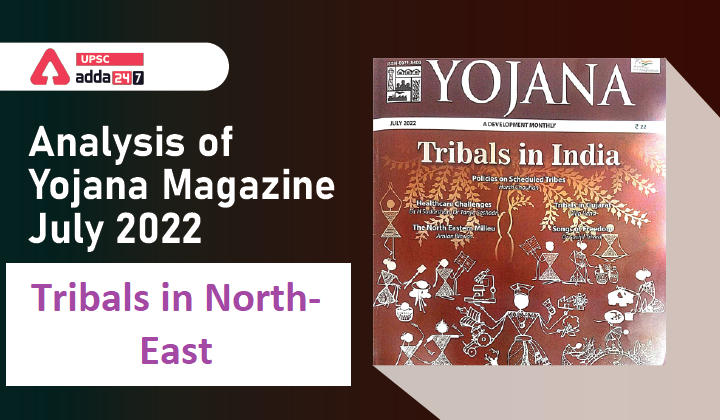Table of Contents
Yojana Magazine is a very important and indispensable source for UPSC Civil Services Exam Preparation. Here, we come with ”Analysis Of Yojana Magazine” which covers the monthly Yojana Magazine keeping in mind the demand of UPSC, particularly from the topics of important government schemes.
In ‘‘Analysis Of Yojana Magazine,” we cover each and every topic of the Yojana edition of a particular month and provide an easy-to-understand gist.
This topic-wise analysis is prepared from the July 2022 edition of the monthly Yojana Magazine.
Tribals in North-East: Introduction
- The Constitution recognizes the Scheduled Tribes (STs) under Article 342 of the Constitution of India.
- Nearly 12% of the total tribal population in India lives in the North Eastern States.
- Unlike the Central and South Indian States, where the tribal population is a minority, tribal communities constitute over 80% of the population in States like Mizoram, Meghalaya and Nagaland.
- North Eastern Region (NER) houses about 133 Scheduled Tribe groups, out of a total of 659 distinct groups presently identified in India.
Tribals in North-East: Which are Particularly Vulnerable Tribal Groups (PVTGs)?
- The level of acculturation and social and economic development varies across different tribal groups.
- The Government of India has also recognized 75 Particularly Vulnerable Tribal Groups (PVTGs), earlier known as Primitive Tribal Groups (PTGs) who need special attention due to their exceptionally low level of development.
- These groups are characterized by primitive levels of technology, declining population and very low literacy rates. Marram Nagas from Manipur and Reangs from Tripura have been categorized as PVTGs in the NER.
- Moreover, more than 80% of the population of Meghalaya, Mizoram and Nagaland is tribal.
- The abundance of these groups in the NER and the geopolitical importance of the region make it essential to focus attention towards their development.
Tribals in North-East: Brief Geography Of NER
- The Northeastern states account for about 8% of the country’s land area and are inhabited by 3.8% of India’s total population.
- The 8 states of Nagaland, Meghalaya, Mizoram, Manipur, Assam, Arunachal Pradesh, Tripura and Sikkim form the North Eastern Region (NER) govern India’s gateway to South East Asia.
- The NER is of considerable economic importance and geopolitically sensitive given their strategic location.
- Two distinct types of agricultural practice in NER:
-
- Settled agriculture in the plains and valleys and gentler slopes
- Slash and burn cultivation (jhum) in the hilly states
- In the lowland areas of the Brahmaputra and Barak valleys, three agricultural systems of rice are followed, namely Sali kheti, Ahu kheti, and Bao kheti.
- Forest products have been the source of food and fuel.
Tribals in North-East: Important tribal festivals in NER
Each society has its own cultural tradition and social system which includes different modes of festivities which are mostly related to agriculture. This include:
- Arunachal Pradesh – Moh-Mol (Tangsa), Mopin & Solung (Adi), Oriah (Wancho), Nyokum (Nyishi), Reh (Mishmi), Lossar (Monpa), Boori-Boot (Hill Miris)
- Assam – Magh Bihu, Bohag Bane, Ali-Ai-Ligang (Mishing), Baikho (Rabha) and Baishagu (Dimasa)
- Nagaland – Moatsu (Ao), Ngada (Rengma), Monyu (Phom), Naknyulutn (Chang), Sekrenyi (Angami) and Suhkruhnye (Chakhensang)
- Manipur – Lai Haraoba dance, Thabal Chongba dance and Raslila
- Mizoram – Chapchar Kut, Mim Kut and Cheraw (the Bamboo Dance)
- Tripura – Garia Puja, Kharchi Puja, Ker Puja and others
- Meghalaya – Wangala Festival (Garo), Shad Suk Mynsieum (Khasi) and Behdienkhlam (Jaintia)
Tribals in North-East: The decline of the tribal population in NER
- In recent years it is seen that the tribal population in NER is on the decline.
- Tripura has witnessed a decline from 56% in 1951 to less than 30% in 2001.
- In Arunachal Pradesh, the tribal population has declined from 90% in 1951 to less than 64% in 1991.
- Bodo Tribes who are a plain land tribal community of Assam have become a minority in many areas of Bodoland Territorial Region.



 TSPSC Group 1 Question Paper 2024, Downl...
TSPSC Group 1 Question Paper 2024, Downl...
 TSPSC Group 1 Answer key 2024 Out, Downl...
TSPSC Group 1 Answer key 2024 Out, Downl...
 UPSC Prelims 2024 Question Paper, Downlo...
UPSC Prelims 2024 Question Paper, Downlo...
